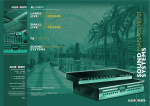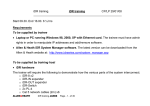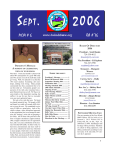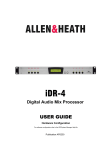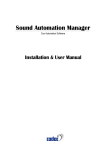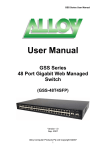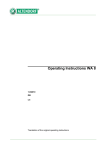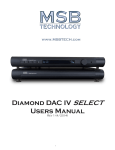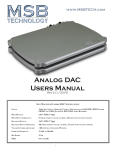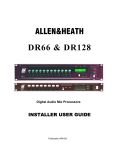Download ALLEN & HEATH DR66 Specifications
Transcript
ALLEN&HEATH ALL RANGES ALLEN&HEATH Kernick Industrial Estate Penryn · Cornwall TR10 9LU · UK +44 (0)1326 372070 fax: +44 (0)1326 377097 tel: email: [email protected] website: www.allen-heath.com www.idrseries.com Allen & Heath reserve the right to alter any information supplied in this document or any other documentation supplied hereafter. Training courses for iDR system building are available worldwide. Check www.idrseries.com for details or email [email protected] AP5909 ALLEN&HEATH ALLEN&HEATH SOUND MANAGEMENT ALLEN&HEATH is trusted by hundreds of thousands of audio professionals to provide outstanding audio to venues around the world. For over 35 years, we’ve produced great mixers for recording, broadcast, live sound, installed systems and DJ’s, and our hands-on experience is second to none in the industry. ALLEN&HEATH SOUND MANAGEMENT SYSTEMS IN ACTION Worldwide venues using A&H Sound Management Products Maritime Rescue Centre Helsinki, Finland Apeldorm Cultural Centre Speyer, Germany Natural History Museum We’ve always been at the forefront of audio engineering innovation: the first computer-controlled mixer on the market in 1984 (CMC); the first dual function live desk (GL3) in 1992; the first digital live sound console (Icon) in 1998; the first affordable VCA console for live sound (ML5000) in 1999 and first high-quality DJ mixers (Xone) for clubs and DJs in 2000. Our sound management products benefit from not only years of software and digital audio development, but also from years of crafting fine audio performance - to produce the best of both worlds! London, UK European Parliament Strasbourg, France OneWorld Sports Bar Sydney, Australia Montsouris Hospital France Bristol Dental School UK Hempfield United Methodist Church PA, USA Rennes Ice Rink We developed our first truly ‘contractor’ product in 1994, when the GR1 zone mixer was introduced. It was welcomed as a high-audio-quality zoner, which not only offered a large number of inputs and outputs, but lots of user configuration options so that the installer or engineer could create exactly the system he wanted. This flexibility proved to be the key characteristic which drove the development of the DR series of DSP zone mixing systems in 1997 - the software offered the user a huge number of features and options for using the processing power of the unit to create the ideal setup. Into the 2000’s, the iDR Series followed this lead and offered a vast array of control and processing options whether over the internet, via networks or our proprietary PL-Anet system - and is now growing into many contractors’ preferred system of choice for managing sound systems in venues the world over. Now, ALLEN&HEATH has a solution for any audio installation, of whatever size or complexity: ✱ The GR05 offers 5 input, 4 output analogue zoning, flexible architecture and numerous configuration options for venue sound distribution. ✱ DR66 is a 6 in, 6 out DSP matrix mixing solution, which allows the installer to program a huge number of parameters of the system by software before installing hardware ✱ iDR is a range of hardware units and remote controllers which offer multiple options for configuration and control of high quality live sound and fixed installations. Since the early 1990’s, ALLEN&HEATH products have been at the heart of venues’ audio systems in auditoria, bars, conference centres, cruise ships, shopping malls, clubs, theatres, lecture theatres, theme parks, stadiums, houses of worship and a whole host of unlikely places such as search and rescue centres, funeral parlours and roller coaster rides! Berjaya Times Square London, UK Lighthouse Evangelist Church Singapore Bogani Cafe Oporto, Portugal MI5 Building London, UK The Terrace Hotel Macherafelt, N.Ireland Tours,Cathedral France Sports Café chain UK Drugstore Publicis Paris, France Barry’s Douglas Speicherstadt No.10 Ireland Muenster, Germany Fire & Ice Club Ipswich, UK Hornsby RSL Sydney, Australia Ministry of Sound Taipei, Taiwan Cock and Bull live music pub Auckland, NZ Intermarché Hypermarkets France Millennium Centre Martin, Slovakia Alton Towers UK BBC Outside Broadcast UK Lockheed Martin USA Aquadisiac Club Singapore Aruba Bar UK Tottenham Hotspur F.C. Ticket Office UK MLP Finance Group Jockey Club Aberdeen University EDSA Shangri-La Hotel 2 Kuala Lumpur, Malaysia Bloomberg Studios Ferrari Store What’s your application? France Germany Rome, Italy Hong Kong, China Scotland Manila, Philippines iDR SERIES WHAT IS IT? iDR SERIES WHY IS IT SO USEFUL? Network control Automatic Level Management Audio Quality The main iDR units can be easily controlled and programmed with an Ethernet connection to a PC [or MAC running OSX & PC simulator]. All iDR units on a network can be ‘seen’‚ by more than one computer, with optional password protection so that operators can be observed by a technician running iDR System Manager software - or PL Client software - anywhere on the network or World Wide Web. iDR can even output a log of its activities to an email address! iDR is equipped with several powerful modules to manage a distributed sound system, so an operator or technician doesn’t always need to be present. For instance: Low latency [2.23ms from input to output] and a fixed DSP architecture ensures that the iDR system will distribute coherent audio no matter how many modules of DSP are used in the system. Proprietary TCP/IP devices such as ‘WiFi’‚ can be used for cost effective and practical uses; for example, a ‘wireless laptop’‚ can be used to commission or update the sound system from exactly where the technician needs to monitor it. Preset System The iDR is a 16 x 16 matrix mixer with an extensive array of audio management tools designed to reduce the need for additional devices to be specified for an installation, or carried in the hire inventory. Pedigree ALLEN&HEATH preamps, 24bit converters and fixed DSP architecture ensure that concert-quality low-latency sound is delivered efficiently to where it is needed. Anyone with a basic knowledge of traditional console and outboard equipment will be able to design a distributed audio system on their PC using the ‘mixer’ based iDR System Manager software - download it free from www.idrseries.com. iDR comes loaded with flexible DSP tools, essential in sound system configuration and installation. Input & output delays, 4- and 8-band parametric EQ, automatic microphone mixing, frequency conscious dynamics, look-ahead limiter, ambient noise compensator, crossfader and much more are available at your fingertips without having to worry about running out of DSP. Its system of presets allow for full recall of the whole system or individual parameters at the touch of a button. After programming, the iDR unit operates as a stand-alone system controller, with a host of remote control devices available for day-to-day operation. The PL Series complements the powerful features of iDR and comprises wall plates, infra-red hand-held or desk mount controllers connecting to the main unit using CAT5 cable over the RS485-based proprietary PL-Anet bus, while all the major third party devices may also be used to control iDR. For complex systems, the iDR system can be driven in real time by a PC via an Ethernet port, allowing the iDR to be used in hire/live audio situations such as matrix distribution in theatres, or clean feed system for an outside broadcast. Why not connect a WiFi card to your laptop, connect to the internet, set up your system and save your settings on the move? Stay in control from anywhere in the world! 4 iDR provides a system of up to 250 presets for total recall of system settings. A preset can contain the settings for all system devices, e.g. a default preset to set the entire system on power-up, or individual devices can be selected for exclusive change in a preset, e.g. a single EQ or fader gain level. A recall crossfader is provided to fade between different preset levels. Sheduled preset recalls are available, timed from the iDR internal clock. Preset recalls can be triggered from ALLEN&HEATH equipment (PL controllers other iDR's or iDR-Switch) or via the serial, MIDI and Telnet ports using third party equipment. PL-Anet The PL Series is the perfect interface between the iDR and the operators on site, providing simple, non-technical switch, indicator display, fader, IR and encoder control options. Furthermore, as the requirements grow at an installation, the control system can too. PL remotes can simply daisy chain or use the ‘PL-Anet’ hub for star wiring applications, and all cabling is CAT5. You as the designer can customize these ‘plug-n-play’ remotes to do exactly what the customer needs. Each PL has its own simulator in iDR System Manager software, so you can design and demo the system offline as it will appear when the hardware is in place. ✱ Microphones in a conference situation can be controlled by any one of the four on-board AMM’s, so that as more open microphones join in, the gain of the sum is reduced to prevent feedback occurring. ✱ A comprehensive Ducking system is provided with adjustable priorities. ✱ Ambient Noise Compensator (ANC) enables the output level in a zone to be automatically managed in relation to the signal level of the changing background noise level ✱ Level Sensing provides a logic or soft LED output when a pre-set signal threshold is reached, which triggers indicators and other hardware to respond; this allows operations such as camera following. ✱ 2 independent paging systems are provided, with paging to selectable outputs. Paging switches and indicators can be triggered via A&H controllers; alternatively, custom paging panels can be created and interfaced with the system. Expandability As the system requirements grow, additional iDR units or expanders can be added to suit the budget and application. iDR-8 and iDR4 have 8-buss digital expansion ports (RJ45) to allow units to be daisy-chained together, or to add an iDR-In or iDR-Out 8-channel expander. The CAT5 cables allow the units to be placed at distances up to 250m apart, allowing, for example, the iDR-In to provide 8 XLR mic/line inputs in a function room on a different floor to the control room containing the main iDR unit, or, similarly, the iDR-Out could be configured as a four-way-stereo XLR output to an amp rack located at the side of a theatre stage. Furthermore, the 8-buss link can be used to distribute signals around a complex network where iDR units communicate via TCP/IP - here, interbox paging and routing is possible. Mic preamp gain is controlled in analogue under software control so levels can be optimised in real time if needed. iDR-8 has a hardware limiter before the A-D converter so that the contractor can have confidence in the signal integrity, even if input levels exceed what was expected. Signal Processing The iDR-4 & iDR-8 signal processing architectures provide 16 channels of input processing and 16 channels of output processing, centred around the 16x16 mix matrix. Using the DSP patchbays, the user can configure these channels to either analogue inputs/outputs or to channels on the digital audio expansion port. DSP Because of the fixed architecture, you do not need to assign DSP into the signal path, or worry about having enough DSP available to do the job. In iDR, we have given you the tools you need such as noise gates, compressors, delays, parametric EQ and look-ahead limiters, to start working with live audio straight away. Adjustments are made in real time as there is no compiling to do, and our unique monitor buss allows you to listen to any point in the signal path. Copy and paste any DSP settings to quickly build up a design, save it as a configuration file, and use it as a template for other systems. MIDI iDR-8 is equipped with MIDI in/out/thru and custom MIDI commands can be output as presets and recalled on the iDR. This allows other audio devices such as samplers and processors to be controlled from the main unit. For example, dynamic MIDI control from faders, rotary controls and keys in the iDR system could interface with a DMX controller, so that basic lighting control can be programmed into iDR and run from the PL series remote controllers. iDR -8 iDR -4 Features of iDR-8 Features of iDR-4 ✱ iDR DSP system - 16 processing channels (inputs and outputs) ✱ 8 analogue mic/line inputs on XLR ✱ ✱ 2 line outputs on TRS jack ✱ Digital audio expansion port with 48V phantom power ✱ 8 analogue line outputs on XLR 2 line inputs on TRS jack ✱ Hot Plug‘n’Play PL Series High Quality Audio Signal Path and ✱ DSP processing ✱ Headphone monitor with mouse and ✱ MIDI in/out/through connections iDR DSP system - 16 processing channels (inputs and outputs) ✱ ripple-through compatibility (8 channels in, 8 channels out) Remote controllers 6 ✱ 2 analogue mic/line inputs on XLR with 20V phantom power ✱ 4 analogue line inputs on TRS jack ✱ 4 line outputs on XLR ✱ 2 line outputs on TRS jack ✱ Digital audio expansion port ✱ Hot Plug‘n’Play PL Series Remote controllers ✱ High quality audio signal path and DSP processing (8 channels in, 8 channels out) ✱ Monitor with mouse and ripplethrough compatibility iDR -In & -Out EXPANDERS iDR CONTROL iDR-In A glance at the iDR back panel reveals the scope of iDR’s control capabilities. iDR can communicate with many forms of equipment utilising industry standard communication protocols. For example, iDR-switch units, iDR-in and iDR-out expanders, third party controllers, PL Series ‘intelligent’ wall plates, MIDI show controllers, PCs, networks and modems. Up to 4 communications ports can be used at once - network and DR-link ports are always available, with two more selected from RS232, Sys-Net, MIDI and PL-Anet. Rear panel LEDs clearly indicate active ports for rapid communication status checking. COMMUNICATIONS PORTS - iDR System permanent protocols connections Network protocol type uses Network control and communication between computers, connection of iDR System Manager, PL-Designer and PL-Client. Connection to the internet for remote iDR-Out management and control purposes DR-Link iDR-Switch to the iDR units for logic control. iDR-8 and iDR-4 can happily manage many complete systems with their existing input/output architecture standing alone. However, for larger systems, iDR-In and iDR-Out audio expander units are available, providing an additional 8 mic/line inputs on XLR and 8 line outputs (also on XLR) respectively. One or both expanders may be connected to a single iDR main unit. These audio expanders convert the analogue audio to an 8 channel wide digital bus which feeds the main iDR unit, which can be up to 250 metres away, via CAT5 STP cable. iDR-In features high grade mic/line preamps with PC configured gain, pad and phantom power switching via DR-Link, and a built-in soft clip, while iDR-Out provides electronically balanced differential outputs. Both units have 8 front panel LEDs in addition to the 3 status indicators; these are 3-colour soft LEDs which can be assigned as audio meters, mute indicators or presets related indicators and are programmed in the usual way using the iDR System Manager software. Example Combinations: 2 of 4 protocols selectable from software Sys-Net For third party controllers such as: AMX, Crestron, Cue, Audace and many more. Touch screens, Infr-red devices etc can be utilised with iDR. RS232 For connecting iDR to a phoneline for remote connection, management and operation (PPP = Point to Point Protocol). RS232 Front Used to update the system code in the unit 6x6 8 Inputs Links the iDR-In and iDR-Out audio expanders and 10x10 Local Inputs Many iDR Units can be inserted on the digital audio bus Local Outputs 6x14 (iDR-8 only) 10 Outputs 10 Inputs 16x10 Local Inputs Many iDR Units can be inserted on the digital audio bus Local Outputs 8 Outputs 8 MIDI 6 Outputs 6 Inputs (iDR-8 only) 16x16 PL-Anet For Remote Control using standard MIDI interfacing equipment. Custom remote controllers, show control, MIDI conversion equipment (e.g. MIDI to DMX) to control external equipment (e.g. lighting) PL-Anet is an RS485-based protocol incorporating 20V phantom powering for the ALLEN&HEATH self detecting and self powered PL Range of remote controllers. iDR System Technical Specifications Audio Specifications Performance Frequency Response Inter-channel Crosstalk THD + noise Residual output noise Input to Output noise 20Hz to 20kHz +0/- 0.5dB <-80dB @ 1kHz, 0dB gain <0.01% @ 1kHz, 0dBu <93dBu (22Hz to 22kHz) <87dBu @ 0dB (22Hz to 22kHz) iDR-8 - number iDR-4 - number Connections Type Impedance (pad out) Impedance (pad in) Gain Sensitivity (pad out) Sensitivity (pad in) Max Input Limiter 8 (expandable to 16) 2 (expandable to 10) Female XLR 3 Pin Electronically Balanced, pin2+ 2k ohm >10k ohm Control in 3dB steps, 20dB pad -50 to -5dBu -30 to +15dBu +33dBu Pre-ADC opto - 6dBFS, switchable Phantom Power +48V switched (iDR-8) +20V switched (iDR-4) Headphone Output (iDR-8 only) Front Panel (face plate fitted) Connections Type Impedance Control Display Type Display content 2 x 16 Character Backlit LCD Day/Time, unit name, user defined text, Menu/operating control data Keys iDR-8: 16 user programmable, 2 scroll iDR-4: 8 user programmable, 2 scroll iDR-8: 32 user programmable, tri-colour iDR-4: 16 user programmable, tri-colour iDR-8 only: Recessed Socket and Level Trim TRS Jack, Tip L Ring R 1/4" Stereo Jack For Headphones >30ohms Front Panel Trim Control DSP Processing Sampling Rate Audio matrix (48kHz) Latency XLR in to XLR out with Processing LEDs 2x Motorola 56bit mix accumulator 48kHz 16 x 16 channel processing <2.3ms Headphones Front Panel (face plate removed) Menu Keys Menu Items Menu item select using: scroll, esc, enter Preset Recall, Monitor Select, date/time, unit name, network, diagnostics 24bit 109dB A-weighted, 106dB unweighted Status LEDs RS232 Connector iDR-8 only: Slave, Ext. Sync Lock, 96kHz iDR-8 only: 9 pin D Connector Mirrors Port A protocol setting, front/rear selection switch 24bit 115dB A-weighted, 112dB unweighted Code Update Label Strip Updates iDR operating system code Behind widow user label/markup strip A/D Converters Resolution Dynamic Range D/A Converters Resolution Dynamic range TRS Jack Line Inputs Expander Input Port Power Supply iDR-8 - number iDR-4 - number Connections Type Impedance Sensitivity Max Input Application Type Connector Power Lead Supplied Power Switch AC mains input 2 4 TRS Jack (balanced/stereo Jack) Electronically balanced, tip+ >30k ohm 0dBu +18dBu Connection Protocol Cable XLR Line Outputs 8 (expandable to 16) 4 (expandable to 12) Male XLR 3 Pin Electronically balanced, pin2+ <75 ohm +18dBu adding remote inputs (iDR-in) and linking iDR units on 8 channel digital bus RJ45 Propietary 8 Channel Digital Audio CAT5 STP upto 250m (825 feet) Expander Output Port Application iDR-8 - number iDR-4 - number Connections Type Impedance Max Output iDR -Switch Technical Specifications DSP XLR Mic/Line Inputs for iDR-8 & iDR-4 Connection Protocol Cable adding remote Outputs (iDR-out) and linking iDR units on 8 channel digital bus RJ45 Propietary 8 Channel Digital Audio CAT5 STP upto 250m (825 feet) Universal Input Switched Mode IEC 3pin Country Dependent Rear panel mains on/off 100-240V AC 50/60Hz Power Consumption (Max) iDR-8: 80VA iDR-4: 75VA Internal Fuse iDR-8: T1.6A 20mm iDR-4: T1A 20mm iDR-switch extends the capability of the iDR-8 and iDR-4 by enabling custom wall plate and remote equipment control. It provides 24 switch closure inputs and 16 logic control outputs which can be custom wired by the installer to suit the application. Up to 3 units can be networked, so providing an iDR unit with 72 switch and 48 logic outputs. The controls are easily programmed using the System Manager software. Control Functions Software When a switch contact closure status is ACTION ON (Pressed) or ACTION OFF (released) various parameters can be controlled within the iDR system: iDR System Manager has a simulation of iDR-Switch units connected to the iDR unit (maximum of 3 per unit). The Switch can be setup online or offline and has the ability to show Logic outputs as green LEDs. Setting up the contact closures and logic outputs is done in the Soft Keys and Soft LEDs setup windows. Many external devices can be integrated into a system using the iDR-Switch units and custom paging panels and remote triggering can be realised. ✱ Levels [Up/Down] (Input, Output, Crosspoint, Monitor) ✱ Group Levels [Up/Down] (Input, Output, Crosspoint) Dimensions iDR-8 iDR-4 ✱ Desktop Width Height Depth 440mm (17") 92mm (3.5") 350mm (14") 440mm (17") 48mm (2") 350mm (14") Mutes [Toggle/On/Off] (Input, Output, Crosspoint, Monitor) ✱ Preset Recall [offers all associated functions] Rackmount Width Height Depth (2U) 486mm (19") 88mm (3.5") = 2U 350mm (14") (1U) 486mm (19") 44mm (2") = 1U 350mm (14") TRS Jack Line Outputs Quantity Connections Type Impedance Max Output 2 TRS Jack (balanced/stereo Jack) Electronically balanced, tip+ <75ohm +18dBu Max depth with connectors Depth 430mm (17") ✱ Monitor Select [Inputs/Outputs] ✱ MIDI Strings - iDR-8 only (a custom MIDI string is sent from the iDR Unit) A range of different modes of operation for each switch closure and logic output can be achieved. Many systems can be integrated with the iDR-Switch, e.g. - 430mm (17") Operating Modes Control & Communications Control Ports Network (TCP/IP) offering the following combinations Application PORT A RS232 PORT B Sys-Net Connection RS232 RS232 RS232 Sys-Net MIDI (iDR-8 only) PL-Anet Custom Serial PL-Anet Settings PPP Setup Cable Sys-Net MIDI (iDR-8 only) Custom Serial Custom Serial MIDI (iDR-8 only) PL-Anet MIDI (iDR-8 only) PL-Anet Front Panel Connector Rear Panel Connector Baud Cable Length Front panel switch to select either front or rear RS232 connector 9pin D Female (Modem) 9 Pin D male 115200, 8N1 <3 Metres (10feet) MIDI (iDR-8 only) Application Connection Protocol Applications Connection Protocol Cable Network for ALLEN&HEATH PL Series intelligent remote controllers RJ45 Application Remote Parameter Control via MIDI sequencer/Interfaces, Show Automation Opto isolated MIDI IN, OUT, THRU 5 pin DIN Note on/off, program change, NRPN, Custom Strings Connection Protocol Cable Proprietary ALLEN&HEATH CAT5 STP up to 250 metres (825 feet) Theme Park Triggering ✱ Room Dividing ✱ Latched Action ✱ Custom Paging Panels ✱ Press Action ✱ Custom Switches for Level control ✱ Release Action ✱ External Equipment interfacing (e.g. Start/Stop for a motor unit utilising a suitable relay interface) Proprietary ALLEN&HEATH - RS485 with +20VDC Phantom Power CAT5 STP (Refer to REN table lengths) iDR-Switch and iDR audio expander logic control RJ45 Fire Alarm Interface ✱ Front Panel Status LEDs Link, power Switch Inputs x 24 Connector 3x 10pin Phoenix, 8 switches per connector Plug Mating screw terminal plugs supplied Type Opto-isolated via 2k2 ohm from +10V Operation Switch closure to connect pin to ground (5mA) Cable 1k ohm max resistance Logic Outputs x 16 Connector 4x 10pin Phoenix, 4 outputs per connector Plug Mating screw terminal plugs supplied Logic Outputs x 16 (continued) Type Opto-isolated open collector Terminals Floating collector (+) and emitter (-) pins Internal DC source +10V, 500mA total max. External DC source. Up to +24V 200mA sink per output max DR-Link Application Connection Protocol Cable Logic control from iDR-4/8 RJ45 x2 (in, out to next unit) Proprietary Allen & Heath CAT5 STP up to 250 metres (700 feet) Power Supply Type Connector Power lead supplied AC mains input Power consumption Fuse Power switch Universal input switched mode IEC 3pin Country dependent 100-240V AC 50/60Hz 15VA max T500mA 20mm Rear panel mains on/off Mechanical specifications (in mm) Removeable ears for desk or rack mount Width iDR-switch Desktop Rack Unpacked weight Packed weight 440mm (17.3") 486mm (19") Height Depth 48mm (1.9") 44mm (1.75")(1U) 148mm (5.8") 148mm (5.8") 3.5kg, 7.7lb 4kg, 9lb PL-2 OUTPUTS INPUTS The PL-2 is a purposebuilt custom interface for iDR-Switch available from A&H for those who do not wish to make their own custom panels. Sys-Net Application Connection Protocol Baud Rate Cable 10 iDR System Manager, PL Designer/ Client, Telnet RJ45 Ethernet MDI/X Switch For Hub or Direct connection DHCP, IP address, Net mask, Gateway Host IP, client IP, user name, password CAT5 UTP up to 100metres (330 feet) DR-Link RS232 Port Select PL-Anet ✱ Technical Specifications Remote Parameter Control, Third Party Controllers (e.g. AMX) RS232 9pin D Female ALLEN&HEATH Sys-Net, Custom Serial Strings Custom settings available <3 Metres (10 feet) The wallplate has 4 user-programmable switches and 4 tricolour programmable LEDs providing many local control options such as multiple source selection for output zones. PL -Series The PL series is the perfect interface between the iDR and the operators on site who don’t need to understand the sound system - just control it. As the requirements grow at an installation, the control system PL-7 can too! Start off with just the controls and display on the iDR unit then add wall mounted plates and handheld remotes wherever they are needed using our CAT5 PL-Anet cabling system. PL remotes can simply daisy chain or use the PL-Anet hub for star wiring applications. LEDs in the system can be tri-colour status indicators [to indicate selected sources, or mutes] or they can become meters for any point in the signal flow. The LCD windows can easily be programmed to relay text information about the state of the system. You, as the designer, can customise these plug and play remotes to do exactly what the customer has been PL-7 is a stand-alone or surface mounted LCD panel, which enables remote display of status information and text messages which can be stored in the recallable memory settings. The PL-7 can be embedded with PL-3 or PL-4 wall plates, allowing programmable control from a single unit. It can also be used for remote alarm/supervisor display. looking for. Each PL has its own simulator in iDR system manager software so you can design and demo the system offline as it will appear when the hardware is in place. PL-8 PL-3 & PL-4 PL-8 is a 4 input, 4 output logic control panel mounted on a wall plate which can be connected to PL-Anet. It is designed to interface external systems such as alarm systems, juke boxes, room dividers, fader starts and lights at a convenient location. PL-3 and PL-4 wall plates have 4 or 2 programmable switches and 4 programmable tri-colour LEDs and are ideal for local operator control of the iDR-based audio system. They may be used, for example, for source selection for an output zone, or local volume control. The PL-4 has, in addition, a rotary control with LED ladder and a built-in infra-red receiver - it can be operated at a distance using the PL-5 handheld remote controller, allowing the operator to quickly and conveniently adjust the system from anywhere in the room. The control options can be different to those set on the PL-4. PL-6 The PL-6 is ideal as a remote mix controller - e.g. as a simple operator-controlled fader panel in an installed sound system, or as a personal musician’s on-stage mix controller with in-ear monitors. It has 8 faders, 24 tri-colour LEDs and 16 soft switches which are all programmable via iDR System Manager. Other examples for use include as a basic lighting controller via MIDI/DMX, and the unit can be wall-mounted or flange-mounted into a table or wall. PL-5 Examples of use: multiple source selection for an output zone. Local volume level, home cinema & AV system control (projector / lighting / amplifier control), and tamper-proof control. PL-9 PL-9 is a 1U rack or desk mount hub which provides up to 7 individual connections to chains of PL devices, offering ‘star wiring’, simplifying wiring and eliminating the need for complex daisy-chaining. This also provides the benefit of longer cable runs and allows easier ‘plug and play’ of devices such as the PL-6 and PL-10, and allows a larger number of PL controllers to be connected to a single iDR unit. As the PL-9 is the ‘end of chain’ on a PL-Anet branch, it offers greater flexibility by allowing PL wallplates to be plugged in and out easily – for example, a PL-6 could just be plugged into a PL-9 onstage, allowing local performer control, then removed after the event. PL-10 The PL-10 is similar to the PL-6 - i.e. is a compact mixer interface, but has 8 rotary encoders, with LED ladder displays instead of faders, making it possible to mix live events within the iDR system. It’s ideal for creating and controlling an output mix of cross-point groups. The PL-10 can be assigned to read and adjust different mixes, as the LED bars indicate the levels managed by the iDR unit. The unit can be hand-held, or flange-mounted into a table or wall. As the PL-10 has encoders rather than faders, it can respond to changes in levels made from other controllers. PL-Calculator PL-Calculator is an Excel-based program which enables the installer to verify that a planned system with specified PL devices and interconnect distances over PL-Anet conforms to the system specification. The program is bundled together with the iDR System Manager software. PL-Anet Specification Application Connection Protocol Cable 12 Network for ALLEN&HEATH intelligent remote controllers RJ45, RS485 with +20V DC phantom power - terminator supplied Proprietary ALLEN&HEATH CAT5 STP (Length table available from ALLEN&HEATH) PL SOFTWARE PL Designer and Client for WindowsTM iDR SYSTEM MANAGER SPECIFICATIONS Operating System iDR Unit Software, Internal Compressor (x16) Update using TCP/IP via system manager, RS232 via Hyperterminal System Configuration As well as being controlled by iDR System Manager, iDR systems can be controlled via a PC using ‘PL Client’, an interface which can be designed in ‘PL Designer’. iDR System Manager software PC compatible running online or offline session. Includes all iDR and PL unit simulators for complete setup and test PL Designer is used to create a custom interface which is opened using Threshold Ratio Knee Makeup Gain Attack Release Auto Modes Display Controls PL Client. The system architect can create a custom wall plate in PL Designer, AMM (x4) -48 to +18dBu Variable 1:1 to 1:infinite Hard, Soft 0 to +18dB 300_s to 300ms, auto mode 100ms to 2s, auto mode Live, Music AGC, Vocal, Speech Response curve, gain reduction, in/out/sidechain meters Compressor in/out, Sidechain in/out, auto on/off Automatic Mic Mixing Ambient Level Sensing Mic open threshold Hold time NOM Attenuation NOM and ambient level average of all selected mics 4 to 20dB above ambient level 0 to 5 seconds 1 to 6dB providing system control taliored to the user’s requirements. PL Designer lets the architect create a control layout from a selection of control types, such as switches, faders, mutes and meters, and positioned over a bitmap background. The architect can map functions from the iDR units into the Designer interface. The resulting PL Client panel, designed and customised according to the client’s preference, can be installed on the client’s PC. The result is the creation of customised, virtual wall plates. The PC can then be directly or network connected to the iDR for system control. Virtual Controllers PL-Designer PL-Client for installer configured GUI for restricted operator control Source Patchbay System Selectable physical source for each input and output channel Eliminates the need for a physical patchbay and signal splitters For example, the system architect could specify in PL Designer that: a and levels of different zones on multiple floors using many iDR systems through one PL Client interface from the client’s passwordprotected computer system. Further levels of access may also be added: for example, assistant managers of the venue may be Input (x16) (iDR-8 only) Time Units Temperature provided with restricted access offering the ability for level control of their designated area only. Output (x16) Time Units Temperature PL Client PEQ PL Client, created with PL Designer, a tool within iDR System Manager, is the end user software, containing only the control elements in a .drd file with the design devices removed for tamperproof operation. Input (x16) PEQ Type Band Type Range Width, Q variable The PL Client software is demo-ware and time limited to 10 days. After that Display Controls Linear fader range Controls 0 to 340ms per channel ms, metres, feet Global Adjust Coefficient for -20 to +40 degrees C Fader Range Number of Input Fader Groups Number of Output Fader Groups Number of Crosspoint Fader Groups Group naming the online documentation and help file contained in the iDR system manager software. Range Crossover filter Width, Q variable Display Controls Metering Input Metering Points Input 8 band fully parametric including crossover filter type HF shelf, LF shelf, Bell, HPF, LPF, notch, crossover filters +/-15dB cut/boost, +/-12dB makeup gain upto 24dB/oct, Butterworth, Linkwitz-Riley, first order 0.5 to 6, constant Q on/off (notch width 10Hz to 100Hz) frequency response curve, meter in/out, reset Gate (x16) Threshold Depth Attack Hold Release Display Controls automatic controlled gain element in step with changes in background noise levels Ambient Level Metering Point I/P Source/Post-EQ/Post-Fade, O/P Post-Matrix/Pre-Fade/Post-Limiter, Channels 1-16 Ambient Level Gain Differential -18dB to +40dB Controlled Gain Element selects fader for control, I/P, O/P, I/P Group, O/P Group, Routing Gain, stereo operation Controlled Gain Operating Range min -59 to 5dB, max Controlled Gain Response Time rate dB per Second from 0.1 to 30dB Program Gap Metering Point I/P Source/Post-EQ/Post-Fade, O/P Post-Matrix/Pre-Fade/Post-Limiter, Channels 1-16 Program Gap Threshold -62dB to -20dB Program Gap Time 0s to 5s Display Level meters, Ambient Level Sampling Active LED Controls Enable On/Off Adjacent channels can be linked for stereo operation Presents single channel strip Processing Linked Matrix routing Linked Stereo Metering Output Band Type Ambient Noise Compensator Stereo Linking 4 band fully parametric HF shelf, LF shelf, Bell, HPF, LPF, notch +/-15dB cut/boost, +/-12dB makeup gain 0.5 to 6, constant Q on/off (notch width 10Hz to 100Hz) frequency response curve, meter in/out, reset www.idrseries.com/pl_client.asp Output (x16) PEQ Type Off to 0dB in 51 Steps 8 8 16 up to 8 characters 0 to 340ms per channel ms, metres, feet Global Adjust Coefficient for -20 to +40 degrees C a key is required to run the software which is available from For more information on setting up and configuring PL Designer/Client view Off to +5dB in 51 steps Level, Mute, polarity reverse Fader Grouping Channel Faders can be assigned to be master faders (DCA) Delay venue manager could control source selects (e.g. CD, SAT-TV, DVD, etc), ANC (x4) Level Control Input channels, output channels, monitor bus, signal generator -72 to +18dBu 0 to -80dB 20_s to 300ms 50ms to 5s 50ms to 1s Level response curve, gate active, in, out, sidechain meters Gate in/out, sidechain in/out Metering Points Outputs Assignable LEDs Metering Meter styling Input Meters selectable source, post-EQ, post-dynamics, post-fade Output Meters selectable post matrix, pre-fade, post-fade, post-limiter Source, Delay, EQ, Sidechain, Gate, Compressor, Fader Delay, EQ, Fader, Limiter (can act as meters) green from 24dBu, yellow from 0dBu, red from +14dBu (4dB below clipping) Extensive on-screen display for all signal points in the signal path Select 1 of 4 meter bar display types Mix Matrix Input / Output channel crosspoint (X/P) matrix Switch/gain matrix Matrix size Fader range Controls Matrix Groups Controls Type Priorities Threshold Depth Release Controls 16 channel multi priority selectable 1 (max) to 16 (min) -48 to +18dBu 0 to -60dB 1 to 100dB/s Ducker Enable On/Off Pager (x2) Type Paging Zone Select Indicators 16 x 16 -38 to 0dB (-inf shutoff) set, clear, mute, individual, row, column, all 16 freely assignable groups Output Limiter (x16) Threshold Attack Release Display Ducking Ducker Depth Controls 2 independent configurable pagers Activated from Front Panel, PL-Anet, MIDI, Sys-Net, iDR-Switch, networked iDR Activated from Front Panel, PL-Anet, MIDI, Sys-Net, iDR-Switch, networked iDR Front Panel, PL-Anet, MIDI, Sys-Net, iDR-Switch, networked iDR 0 to -40dB page mic select, zone select, latching, press to talk, auto cancel Audio Monitor -20 to +18dBu 40us to 400ms 50ms to 1s level response curve, gain reduction, in, out, meters, time versus reduction histogram in/out, fader Ripple through stereo audio monitor Source Select I/P 1-16 source, Delay, EQ, Sidechain, Gate, Compressor, Fader O/P 1-16 Delay, EQ, Fader, Limiter. Channel Outputs 1-16 (routed via output patchbay) Follows Mouse / Active Window Sidechain Filter (x16) Source EQ Switch into either compressor and/or gate 1 Band, type and parameter control as PEQ Signal Generator Source variable frequency Range (sine/band) Controls 14 sine wave, white noise, pink noise, band pass pink noise 20Hz to 20 kHz Fader, Mute DR 66 Technical Specifications 0 dBu = 0.775 Volts rms The DR66 is a Digital Signal Processing Matrix Mixer which can be used for a huge number of sound installation applications. Built around two Processing Engines supplied as standard, this compact 1U rack unit offers digital mixing with EQs, dynamics and automatic mic mixing, and provides routing for signals from the 6 analogue mic or line inputs to be fed to 6 matrix outputs on XLR connectors - a system which can be expanded with additional processing engines and delay options. Internal Headroom DR66 +12dB Maximum Output Level +16dBu into 600 ohms Frequency Response 20Hz to 20kHz +/-1dB Distortion THD better than 0.004% @ 1kHz Crosstalk Interchannel > -80dB at 1kHz Noise 22Hz - 22kHz Mic Ein Line preamp at Mix noise (all routed) -128dB (150 ohms source) 0dB gain -90dBu -80dBu Panel Meters 2 colour Red: Green: Peak -6dB dBFS Signal -42dB dBFS Phantom Power +18V, internal jumper links Power Requirements Mains voltage set for local requirements 50/60Hz 25W max Power Supply Internal regulated hybrid Switch Mode/Linear The DR66 is simple to set up using ALLEN&HEATH WinDR System Manager software and can be controlled either by front panel keys on the unit standing alone, or by many other methods, such as wall plates, touchscreens and the front panel keys. Programmed presets can store parameters of several processing elements and the settings of input, crosspoint and output faders, which can then be recalled manually, or by the timed events processor. The DR66 boasts rear connectors which allow input from a single 24V backup power supply. Power Consumption 25VA Max AC power requirements Factory wired for 100, 120, 220, 230V AC, 50/60Hz mains input Fuse T315mA (220V - 240V AC) T630mA (100 - 120V AC) The DR66 is designed to provide low latency architecture in Digital Signal Processing mixing, and it’s built to the same exacting standards as ALLEN&HEATH live sound desks. Bringing well-featured, high quality audio to every sort of sound installation, this audio zoner offers a low-cost DSP solution for installations such as hotels, conference centres, stadia, retail outlets, restaurants, houses of worship and pubs. DC Power Backup External DC Power Supply Input Nominal +24V DC (+/- 15%) DR66 Fuse 2A (internal) 1 Amp max Mechanical specifications - Dimensions in mm Desktop Width Height Depth 486 (19") 44 (1.7") 350 (14") Sizes do not include feet Weight 7kg (15.4lb) 20-bit Fs x 64 DAC : : 20-bit Fs x 128 Digital Signal Processing LCD Display SysNet Delay Option WinDR Software DR66 is supplied with two Digital Signal Processing Engines (PE’s) as standard, and each has a different contribution to make towards the functionality of the unit. The first PE has a fixed configuration and powers the matrix processor, input and outputs, signal meters, crosspoint matrix, output protection limiters multiple priority ducker, AMM and ‘soft’ insert points for signal processing. The LCD displays active patch number, name, day, time and other information. A real time clock is included for scheduled patch events. SysNet is the ALLEN&HEATH communication protocol used to control the DR unit from external third party remote controllers, such as AMX, Crestron or Audace. Patch recall, input and output levels, mutes and crosspoint levels can all be controlled from such devices via the RS232 port. The DSPd Delay Option provides up to 680mS of signal delay on each output channel. WinDR is a WindowsTM application which runs on PC or networked system. It is supplied with the DR66 for the installer to configure the internal routing and signal processing for the installation. Three main windows are available: ✱ Offline DR Unit simulation window, with front panel controls for remote functions and display options ✱ Input and output channel windows, with show controls for each channel including faders, mute, polarity, naming and crosspoint levels ✱ The resource toolbar which shows the available DSP in resource racks, which can be assigned by dragging onto channels. ✱ WinDR can be investigated before real system setup by downloading it free from the ALLEN&HEATH website. Patches Each DR unit can store up to 99 patches depending on the resources involved. Full patches [affecting all parameters] or partial patches [affecting selected parameters] can be edited using the PC then named and saved to the DR. Sets of programmed patches with channel names, scheduled events details and processor rack details can be saved in configuration files on PC.for system recall. Setup Keys The DR66 has five soft keys on the front panel which can be used to navigate and select available menu parameters. 16 Packed 6.5kg (14.3lb) ADC FEATURES The second PE allows indivitual assignment of signal processing and allows the installer to load ‘resource racks’ of DSP with, for example, parametric EQ’s, graphic EQ’s, noise gates and compressors which may be applied to inputs and outputs. Further DSP may be added with extra ‘DSPx’ expander cards. Unpacked DR Gateway This is an ALLEN&HEATH WindowsTM software utility which allows the DR66 to be controlled via an IP network. This lets the installer access the unit remotely using the WinDR System Manager software via a computer network, through an Ethernet port or dial-up connection. It runs on a host computer via RS232 and its Ethernet port to access the network. iDR Switch The DR66 can be connected via DR Link on CAT5 cable to the iDR-Switch, a 24-in, 16-out switch controller (see page 11). The addition of the switch unit allows extensive use of wall plate and remote equipment control, and provides an additional 24 switch closure inputs and 16 logic control outputs which can be custom wired by the installer to suit the application. Up to 3 units can be networked, providing an extra 72 switch and 48 logic outputs and are programmed using the WinDR System Manager software. External PSU Backup Rear connectors provide input from a single 24V external battery Processing 2 x Motorola 56002 24-bit fixed point Sampling Frequency 48kHz Compatible with BS5839 installation requirements for Alarm systems, plus IEC65, EN60065, UL6500 and CSAE65/94 safety standards PL-1 The PL-1 wallplate has 4 user-programmable switches and 4 tricolour user-programmable LEDs providing many local control options such as multiple source selection for output zones. Technical Specifications GR 05 0dBu = 0.775 Volts rms, +4dBu = 1.23V rms, 0dBV = 1 Volt rms, -10dBV = 316mV rms Maximum output level Impedance balanced +20dBu into 2k ohm Frequency response 20Hz to 30kHz 0/-1dB Distortion - measured at +12dBu 1kHz Line in to Output < 0.005% Crosstalk measured at 1kHz Channel shutoff Interchannel Channel pan < -90dB < -80dB < -75dB Noise 22Hz - 22kHz referred to 150 ohm source Mic EIN Line preamp at 0dB gain Mix noise (all routed) -128dB -91dBu < -86dB Inputs + Output Meters 3 colour LED Red: Yellow: Signal: The GR05 is an affordable yet high quality ‘plug and play’ analogue 1U rack solution for sound installations, mixing up to 2 mic and 3 stereo sources for up to 4 output zones. It presents a very simple interface for the operator, but has amazing installer configurable flexibility protected ‘under the hood’. It provides tools such as level matching, metering, routing matrix , EQ, ducking, VCA remote control and expandability to satisfy the many demands of each installation. Peak: on 5dB before clipping 0dB dynamic indication from -12dB Internal headroom +20dB Routing Assignable 9 in, 4 (x2) Out Crosspoint Matrix Output Levels Control Routed Direct The GR05 is at home in small but high quality professional sound installations providing zoned background music and announcements, with sources such as microphones, CD, 2-track players, retail radio feeds, video sound, jukeboxes, etc. Venues where GR05 can be Routed via VCA found include bars, shops, sports centres, restaurants, public galleries and venue foyers. Ducking options High performance VCA system Internal trimmer -10dBV to +4dBu Front panel level control or External remote level control Switch operated zone mute option link Internal Trimmer -10dBu to +4dBu Ducking - Release fast or slow links Depth -10dB, -20dB or Mute links Internal & External Ducking circuits. Internal Trigger from mic 1 and mic 2 by option links. External Trigger from opto isolated input EQ Mic Inputs HF/MF Swept Peak/Dip, LF Shelf HF Shelf, LF Shelf Outputs Power Supply Internally regulated +/- 15V Mains Power Internal unit AC mains input FEATURES : 2 Microphone Inputs Outputs XLR Routing Matrix Ducking Lock Out System The GR05 is furnished with 2 balanced mic inputs on XLR, both of which have rear panel gain controls. Removal of the top panel allows access to internal jumper links, providing a 30dB attenuator pad, +15V phantom power and a high pass filter at 200Hz. Internal trimmers also provide 2-band EQ, hi-mid frequency with sweep and LF shelving. The front panel has 3-colour LED meters, and level controls for all routed outputs. 4 XLR connectors are provided for the outputs, which are internally configured by the jumper links for -10dBV to +4dBu. The outputs can be grouped and front panel level controls can be disabled using the internal. Internal trimmers also provide shelving EQ for HF and LF. All inputs can be routed to any combination of outputs direct, or via VCA control, so that the direct path is not affected by output level controls and ducking. Matrix assigment is achieved using internal jumper links. The GR05 allows ducking and muting of channels, and is configured either internally on jumpers or externally via an opto-isolated input for external trigger. Input controls are always active; output levels controls may be disabled. All level controls may be set in 3 ways: 1) Knob fitted for operator control 2) knob removed for screwdriver preset 3) hole plugs (provided) fitted to lock out control. Stereo Inputs 3 RCA sockets are provided for stereo inputs, and internal jumper links allow access to -10dBV to +4dBu level matching. 3-colour LED meters and level controls are also provided for the stereo inputs on the front panel. 18 Power consumption Mains fuse rating : Other configurable functions include VCA control and outputs which can be assigned to front panel controls or alternatively, remote control operation. Zone muting is possible via a front panel switch and LED indicator. A status LED on the front panel is provided. Remote Control VCA path remote control can be configured by the installer on internal jumpers. The expander option (using another GR05 acting as slave to the main unit and connected by a 25-pin D connector) includes a remote DC input for each of the 4 outputs. Expander / Remote Additional mic & line inputs can be provided via another ‘slave’ GR05 using the 25-pin D-type female connector. DC Power Backup 100 to 230V a.c. @ 47-63Hz Internally wired to country voltage 18VA max 100-120V a.c. use T630mA 20mm 220-240V a.c. use T315mA 20mm External d.c. power supply or batteries +/-12V to 16V d.c. @ 300mA Mechanical specifications - Dimensions in mm Width Height Depth PSU Desktop 483 (19") 44 (1.7") 260 (10.2") Internal mains voltage PSU. DC backup input is provided. Status indicator. Weight 4kg (9lb)










